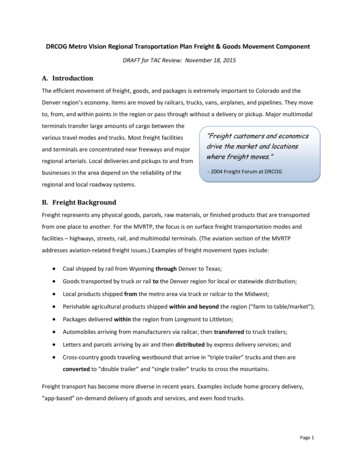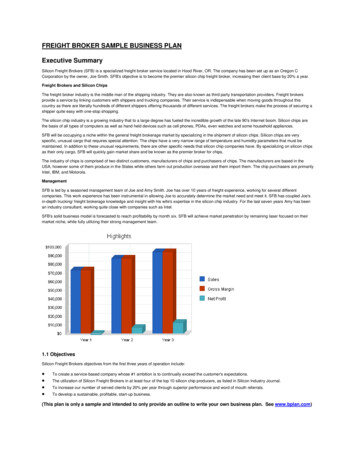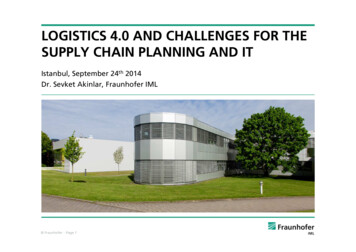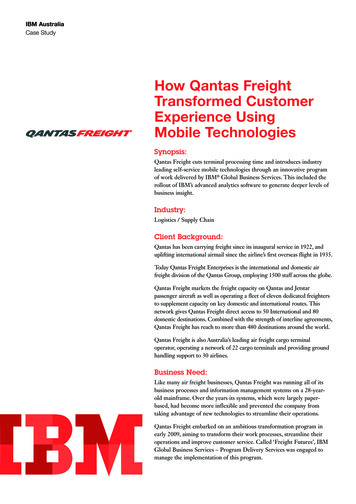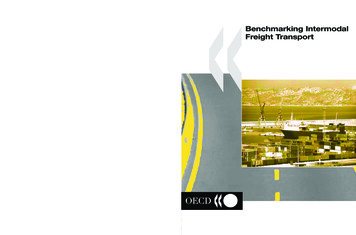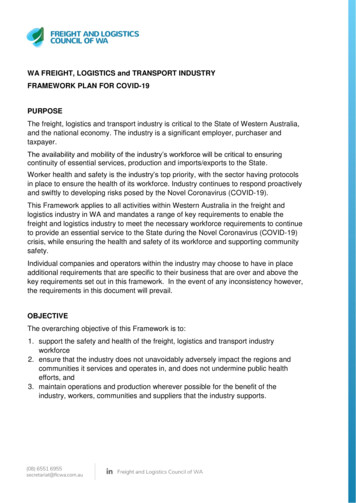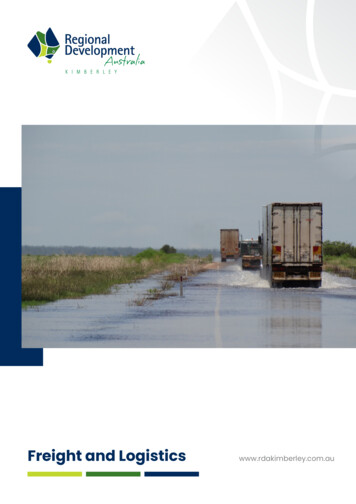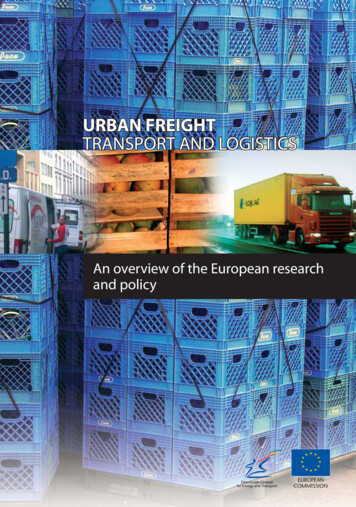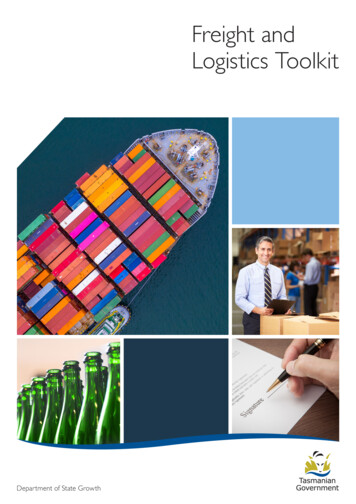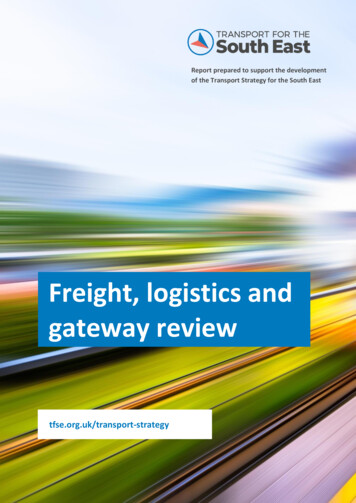
Transcription
Report prepared to support the developmentof the Transport Strategy for the South EastFreight, logistics andgateway reviewtfse.org.uk/transport-strategy
Transport for South EastLOGISTICS AND GATEWAY REVIEWJULY 2019CONFIDENTIAL
Transport for South EastLOGISTICS AND GATEWAY REVIEWTYPE OF DOCUMENT (VERSION) CONFIDENTIALPROJECT NO. 70050793DATE: JULY 2019WSPWSP House70 Chancery LaneLondonWC2A 1AFPhone: 44 20 7314 5000Fax: 44 20 7314 5111WSP.comLOGISTICS AND GATEWAY REVIEWProject No.: 70050793Transport for South EastCONFIDENTIAL WSPJuly 2019
QUALITY CONTROLIssue/revisionFirst issueRevision 07/2019Prepared byIan Brooker /Morag WhiteIan Brooker/MoragWhiteSignatureIan BrookerIan BrookerChecked byAdrian Hames /Ian BakerAdrian HamesAdrian HamesAdrian Hames7005079370050793Revision 2Revision 3SignatureAuthorised bySignatureProject numberReport numberFile referenceLOGISTICS AND GATEWAY REVIEWProject No.: 70050793Transport for South EastCONFIDENTIAL WSPJuly 2019
CONTENTS1INTRODUCTION11.11.21.31.41.5AIMS OF THE STUDYTRANSPORT FOR THE SOUTH EASTBACKGROUND AND PURPOSE OF THE COMMISSIONSTRUCTURE OF THIS REPORTMETHODOLOGY113442NATURE AND STRUCTURE OF FREIGHT AND LOGISTICS62.22.32.42.52.62.7LOGISTICSSIZE OF THE INDUSTRYECONOMIC IMPORTANCE OF LOGISTICS IN TFSEROLE OF MODESKEY LOGISTICS TRENDSIMPACTS OF LOGISTICS6781011123POLICY REVIEW153.23.33.43.53.6NATIONAL POLICYNATIONAL IMPORTANCE OF INTERNATIONAL GATEWAYSLOCAL POLICYPLANNED INFRASTRUCTURE INVESTMENTCONCLUSIONS FROM LOCAL POLICY15272938394LOGISTICS IN TFSE404.14.24.34.44.54.6FREIGHT GENERATORS AND HUBSDISTRIBUTION CENTRES AND HUBSOTHER INDUSTRIESROAD FREIGHTRAIL FREIGHTCONCLUSIONS ON FREIGHT MOVEMENTS4041444653565KEY GATEWAY PROFILES585.15.25.35.45.55.65.75.8OVERVIEWPORT INTRODUCTIONSAVIATIONRAIL GATEWAYSTFSE PORTS RANKINGSTFSE AIRPORTS RANKINGSGATEWAY DASHBOARDSKEY ISSUES AND OPPORTUNITIES5859616363656691LOGISTICS AND GATEWAY REVIEWProject No.: 70050793Transport for South EastCONFIDENTIAL WSPJuly 2019
5.9OPPORTUNITIES926LOGISTICS AND LONDON946.16.2FREIGHT TO LONDONIMPACT OF LONDON FREIGHT POLICIES94947CORRIDORS AND ACCESS TO INTERNATIONAL GATEWAYS977.17.27.37.47.57.6WHAT ARE THE STRATEGIC FREIGHT CORRIDORS?ROAD CORRIDORSROAD JOURNEY TIMES TO KEY MARKETSPROPOSED LOWER THAMES CROSSINGRAIL CORRIDORSCONCLUSIONS97981031051051078STAKEHOLDER VIEWS1088.18.28.38.4AIMSMETHODSUMMARY OF VIEWSCONCLUSIONS1081081091129FUTURE TRENDS AND FORECASTS1139.29.39.49.59.69.7ROAD FREIGHT DEMAND FORECASTSRAIL FREIGHT DEMANDCHANGES IN LOGISTICSMEGATRENDSBARRIERS TO REALISING THE POTENTIAL OF NEW S AND GICACCESS TO MARKETS AND GATEWAYSROAD ISSUES1271271301321112EVIDENCE GAPSCONCLUSIONS AND NEXT STEPS141143LOGISTICS AND GATEWAY REVIEWProject No.: 70050793Transport for South EastCONFIDENTIAL WSPJuly 2019
TABLESTable 2-1 – TfSE strategic principles and the importance of freight and logisticsTable 3-1 - National policy in relation to freight and logisticsTable 3-2 - Evidence of Local Authorities freight policiesTable 3-3 - Freight specific transport plansTable 3-4 - LEP Economic KPIsTable 3-5 - Employment by LEPTable 3-6 - Priority sectors by LEPTable 4-1 – Warehouse sectors (UKWA, 2016)Table 4-2 – Freight patternsTable 4-3 – Rail freight patternsTable 5-1 - UK total port sector - % total volume change from 2000 to 2017Table 5-2 - TfSE Port Total as percentage of UK Total 2017 (DfT, 2017)Table 5-3 - TfSE Port’s Total Cargo Throughput 2017 (DfT, 2017)Table 5-4 - In breakdown down of TfSE ports by commodity 2017 DfT, 2017Table 5-5 - Breakdown and ranking of TfSE airports by passenger and freight 2017Table 5-6 – Results of international gateway assessmentTable 6-1 – TfL freight actions and their impacts on TfSETable 7-1 - Strategic corridorsTable 7-2 – Key freight corridorsTable 8-1 - Companies interviewedTable 9-1 - HGV% increase from 2015Table 9-2 - LGV% increase from 2015Table 9-3 - Rail freight tonnes forecast (Network Rail)Table 9-4 - Demographic megatrendsTable 9-5 - Social megatrendsTable 9-6 - Environmental megatrendsTable 9-7 - Economic megatrendsTable 9-8 - Political megatrendsTable 10-1 – Gateway challenges and opportunitiesTable 10-2 - Lorry parking in the South East with critical utilisation (AECOM, 2018)Table 10-3 - HGV incidentsTable 11-1 – Evidence gapsLOGISTICS AND GATEWAY REVIEWProject No.: 70050793Transport for South 115119120121122123131132137141CONFIDENTIAL WSPJuly 2019
FIGURESFigure 1-1 – Map of the TfSE area2Figure 2-1 – Source emissions on A33 Southampton (ABP, 2018)13Figure 3-1 – Planned Employment Space Growth (Steer, 2018)35Figure 4-1 -The location of distribution space over 8,000 square metres in England41Figure 4-2 - UK Warehousing space 2016 (UKWA, 2016)43Figure 4-3 – Selected major distribution centres (WSP)44Figure 4-4 - Types and Sources of Aggregates in TfSE in 201445Figure 4-5 - Volumes of goods lifted on UK registered goods vehicles47Figure 4-6 – Annual volume of freight in HGVs from TfSE to other areas (2017, CSRGT) 48Figure 4-7 – Annual volume of freight in HGVs from other areas to TfSE (2017, CSRGT) 48Figure 4-8 – Number of HGV operators per km2502Figure 4-9 – Number of vehicles authorised per km51Figure 4-10 – HGV daily count52Figure 4-11 – HGV daily count as a percentage of all traffic53Figure 4-12 – TfSE rail terminals by commodity handled55Figure 4-13 – Daily freight trains by corridor (2013, Network Rail)56Figure 5-1 – Kent Thames ports/wharfs (PLA, 2018)61Figure 5-2 - NIC report Freight handled at the UK’s six largest freight airports62Figure 5-3 - UK Airport passenger and freight statistics (2017) (Steer, 2017)62Figure 5-4 - TfSE Airport total as percentage of UK total 2017 (DfT, 2017)65Figure 5-5 – Southampton Port dashboard69Figure 5-6 – Dover Port dashboard70Figure 5-7 – Medway Ports dashboard73Figure 5-8 – Portsmouth Port dashboard75Figure 5-9 – Shoreham Port dashboard77Figure 5-10 – Newhaven Port dashboard79Figure 5-11 – Ramsgate Port dashboard81Figure 5-12 – Heathrow Airport dashboard83Figure 5-13 – Gatwick Airport dashboard85Figure 5-14 – Southampton Airport dashboard87Figure 5-15 – Channel Tunnel dashboard89Figure 5-16 - TfSE Share of Total UK Volumes (2017)92Figure 5-17 - TfSE Share of Total UK Airport Freight Volumes (2017)93Figure 5-18 - TfSE Share of Total UK Airport Passenger Volumes (2017)93Figure 7-1 – HGV drive times from Southampton103Figure 7-2 – HGV drive times from Dover104Figure 7-3 – HGV drive times from Brighton104Figure 7-4 - Baseline train length position for Southampton to the West Midlands106Figure 8-1 - What impact do you think the following trends will have on your business110Figure 8-2 - As a business, what are your top three priorities111LOGISTICS AND GATEWAY REVIEWProject No.: 70050793Transport for South EastCONFIDENTIAL WSPJuly 2019
Figure 8-3 - Three main challenges for your businessFigure 9-1 - Agents that will lead transformations in the sector (OCED/ITF, 2018)Figure 9-2 - Likely trends and innovations by 2030 (OCED/ITF, 2018)Figure 9-3 - Supply Chain Start Ups - CB InsightsFigure 10-1 – Air Quality Management Areas in TfSE (DEFRA, 2019)112116123124137APPENDICESAppendix A: Stakeholder themesAppendix B: Full survey resultsAppendix C: Gateway analysisLOGISTICS AND GATEWAY REVIEWProject No.: 70050793Transport for South EastCONFIDENTIAL WSPJuly 2019
1INTRODUCTION1.1AIMS OF THE STUDY1.1.1.The aim of this study is to provide a consistent view of current and future patterns of freight activityand key cross-cutting issues relating to freight logistics and gateways across the TfSE area andbeyond to ensure that these issues are considered the development of the Transport Strategy. It willdescribe the current pattern of freight activity, analyse the implications of future demand changes,identify how TfSE can capitalise on opportunities and mitigate the risks identified as part of thestudy. This will allow for TfSE to plan for future freight demands and incorporate this into theirTransport Strategy.1.2TRANSPORT FOR THE SOUTH EAST1.2.1.The South East is home to the UK’s busiest international and national transport infrastructure – thebusiest airports serving the most destinations, ports served by the major container shipping lines,cross channel ferries and Eurotunnel, the busiest passenger rail network in the country, and some ofthe busiest motorways, notably the M25, M20, and M3.1.2.2.The Transport for the South East (TfSE) Economic Connectivity Review (2018) identified that thetransport and logistics sector in the South East generates a Gross Value Added (GVA) of over 8billion per year and acts as an influential driver of the UK economy.LOGISTICS AND GATEWAY REVIEWProject No.: 70050793Transport for South EastCONFIDENTIAL WSPJuly 2019Page 1 of 144
1.2.3.TfSE is an emerging Sub-national Transport Body (STB) and covers: Berkshire, Brighton and Hove,Kent, Hampshire, the Isle of Wight, Surrey, East Sussex and West Sussex. The TfSE area includes16 local transport authorities and five Local Enterprise Partnerships (LEPs).1.2.4.Transport for the South East’s (TfSE) vision statement states:“The South East is crucial to the UK economy and is the nation’s major international gateway forpeople and businesses. We will grow the South East’s economy by facilitating the development of areliable, high quality, sustainable, integrated transport system that makes the region moreproductive and competitive, improves access to opportunities for all and protects the environment”.Figure 1-1 – Map of the TfSE area1.2.5.Supporting this are a number of strategic principles:Ensuring the delivery of a high quality, sustainable and integrated transport system that supportsincreased productivity to grow the South East and UK economy and compete in the globalmarketplaceFacilitating the development of a high quality, sustainable and integrated transport system thatworks to improve safety, quality of life and access to opportunities for allFacilitate the delivery of a high quality, sustainable and integrated transport system that protectsand enhances the South East’s unique natural and historic environment1.2.6.The role of TfSE is significant in the development of a transport strategy that covers ageographically significant and economically important area and this is especially important for thefreight and logistics sector. This commission forms part of a larger piece of work to develop theoverall transport strategy.LOGISTICS AND GATEWAY REVIEWProject No.: 70050793Transport for South EastCONFIDENTIAL WSPJuly 2019Page 2 of 144
1.3BACKGROUND AND PURPOSE OF THE COMMISSION1.3.1.Within the context of the strategic priorities, and recognising the reliance on the South East for theUK’s import/export performance, one of TfSE’s aims is to facilitate ‘improved connectivity betweeninternational gateway ports, airports and Eurotunnel Terminals and their markets within the SouthEast and to the wider UK and the rest of the world.’ This was reflected in the Economic ConnectivityReview (ECR) which highlighted the importance of connectivity to the gateways in the South East tothe UK and local economy. It also sets out the case for enhanced connectivity to these gateways tofacilitate further economic growth. Therefore, international gateways are a particular focus of thisreport.1.3.2.The findings from this thematic study will be incorporated into the overarching Transport Strategy.1.3.3.The key lines of enquiry within this study include:Backgroundcurrent conditions and future issues and opportunities in the freight logistics sector and theoperations of international gateways in the TfSE area;the existing economic importance of the freight and logistics sector to the South-Easteconomy;patterns of freight activity and flows identified from existing freight statistics and data fromports and gateway operators, producing plots of flows between key origins and destinations;Stakeholdersviews from port, airports and freight and logistics operators about current and future issuesthey face;Brexitpotential impacts of Brexit, from a freight perspective, noting that this has been considered inmore depth elsewhere as part of the overall Transport Strategy development;Gatewaysprofiles of each of the key gateways in the TfSE area including Eurotunnel and Heathrow(given its proximity to and impact on the TfSE area), including current and future scale ofactivity, their development plans, current surface access arrangements;the role of the economic corridors identified in the Economic Connectivity Review in facilitatingimproved access to gateways;identification of the impact of current planned infrastructure interventions to facilitate improvedaccess to gateways; as well as identifying any additional interventions required to improveaccess on the economic corridors;Futureemerging trends and future influences on demand;LOGISTICS AND GATEWAY REVIEWProject No.: 70050793Transport for South EastCONFIDENTIAL WSPJuly 2019Page 3 of 144
collation of the findings of existing research and evidence on the potential impact of evolvingtechnology, economic conditions and consumer habits; andResearch gaps and conclusionsidentification of gaps in the evidence and areas for further investigation and analysis.1.4STRUCTURE OF THIS REPORT1.4.1.Firstly, the study considers the policy context for the freight and logistics environment and how thisimpacts investment and planning decisions. The study reviews the constituent parts of the TfSEarea, by LEP and by Local Authority. The aim of this is to review the current programme of freightmanagement and how local considerations have been taken into account when planning for freightand logistics at a local level.1.4.2.Having established this context, the study then looks at logistics in the region, including patterns offreight movements, future trends and the economic importance of logistics for the area.1.4.3.Whilst data is essential in understanding the nature, and importance of freight in TfSE, stakeholderneeds and aspirations must also be taken into account to ensure that planning and investment servea real need and are appropriate to achieve the desired outcomes. Therefore, the themes identifiedas part of the stakeholder consultation process are presented.1.4.4.International gateways are of key importance to the region and the UK economy and therefore thestudy has analysed their current and future strengths and weaknesses. The study has used SWOTanalysis to review the performance of the key gateways. The review considers access to gatewaysas part of the assessment of the performance of the key freight corridors in the region.1.4.5.Whist the study has considered a wide range of data sources as well as primary research throughengagement with stakeholders’, gaps in evidence have been identified which will need to be filled toallow for a full picture of freight opportunities and threats to be fully evaluated.1.4.6.The report concludes with high level conclusions and sets out high level interventions available toTfSE for consideration.1.5METHODOLOGYDATA COLLECTION: KEY INPUTS INTO THIS STUDY1.5.1.Whilst there is limited freight data available, there have been a number of important studiesundertaken recently which highlight the necessity for improved connectivity within the freight andlogistics sector. These include:The DfT’s study on Port Connectivity;The NIC Future of Freight Study;Highways England study into International gateways and the strategic road network;TfSE Economic Connectivity review;TfL Freight Strategy; andDfTs Future of Mobility: Urban Strategy.LOGISTICS AND GATEWAY REVIEWProject No.: 70050793Transport for South EastCONFIDENTIAL WSPJuly 2019Page 4 of 144
1.5.2.These, as well as others, will be considered as part of this study.1.5.3.As the wider Transport Strategy develops the proposed infrastructure improvement and investmentswill be included, where this fits within the timelines of this study. This we will supplement this withknown specific freight investments, particularly for Network Rail.1.5.4.The study has reviewed the Strategic Economic Plans produced by the LEPs in the TfSE areas andtransport and economic strategies produced by the local authorities across the area to identify:Scale and location of planned population and employment growthIndustrial and business focus, including clusters of industryTransport investment proposals1.5.5.As part of the data gathering excise the study has reviewed and collated various datasets relating tofreight movements from a variety of sources which include:Continuing Survey of Road Goods Transport;DfT Port Statistics;Traffic counts undertaken by DfT and Highways England; andNetwork Rail’s corridor level PolkaDot model1.5.6.The study has also reviewed data relating to future forecasting; these datasets include:National Road Traffic Forecasts for freight;Ports forecasts;Rail freight forecasts from Network Rail; andEmerging published forecasts from the NIC Future of Freight research.ANALYSIS1.5.7.As well as analysis of the data gathered mentioned above, the study has examined the future bylooking at the significant trends affecting the logistics sector in the TfSE area. The existing policyframework has been reviewed to ascertain how these factors affect the recommendations for futurepolicy making. As part of this the importance of the gateways has been considered as well as theeconomic significance of logistics in the area.STAKEHOLDERS1.5.8.Whilst a robust approach to data analysis is essential to developing an understanding of the freightand logistics industry within the area, stakeholder views from port, airports and freight and logisticsoperators are critical to get a full picture of the needs and aspirations of an industry whichcontributes significant economic value to the area. This enables appropriate interventions to bedeveloped that allow the industry and therefore the area to reach their economic potential. This hasbeen a key part of the study and stakeholders have been engaged throughout the development ofthis study through one to one discussions as well as an online survey to expand the reach andscope of stakeholder views.LOGISTICS AND GATEWAY REVIEWProject No.: 70050793Transport for South EastCONFIDENTIAL WSPJuly 2019Page 5 of 144
2NATURE AND STRUCTURE OF FREIGHT AND LOGISTICS2.1.1.This chapter provides a general introduction to logistics, and considers the economic importance oflogistics generally and in the South East. It goes on to look at the role of each mode involved ininland transport nationally and in the South East and outlines the main drivers of change in thesector.2.2LOGISTICS2.2.1.The Chartered Institute of Logistics and Transport (CILT) defines logistics as “the time-relatedpositioning of resource.” It is also described as the five rights. Essentially, it is the process ofensuring that goods or services are:In the right place;At the right time;In the right quantity;At the right quality; andAt the right price.LOGISTICS AND GATEWAY REVIEWProject No.: 70050793Transport for South EastCONFIDENTIAL WSPJuly 2019Page 6 of 144
2.2.2.The significance of these definitions is that logistics is about much more than transport. Thechallenge facing logisticians is minimising the cost of the entire supply chain while meeting toughdemands from their customers (internal and external) in terms of delivery lead times and otherquality factors.2.2.3.As transport is only one part of complex supply chains, decisions may be made which improve theefficiency of a business overall, but result in the increasing of distances that goods are transportedor their frequency (potentially leading to lower average payloads and more movements). Primeexamples include centralisation, just in time manufacturing, and same day or same hour deliveries.For example, just in time manufacturing (JIT) expects suppliers to deliver just before componentsare required, often at the expense of waiting for a load to be full.2.2.4.The industry can be defined in broadly three ways:Long-haul freight occurs largely along motorways and trunk routes (as well as major railcorridors), moving goods between ports, factories and national distribution centres;Regional distribution consists of shorter, more disaggregated journeys, often from national toregional distribution centres and to out-of-town retail sites; andUrban and last-mile (even last metre) distribution connects regional distribution centres withurban retailers and consumers, usually in smaller, more frequent deliveries.2.2.5.For the TfSE area, all three categories of logistics are important, although long haul freightoriginating from or destined for the international gateways is a key consideration. Therefore, thisfreight study considers all levels of freight movement.2.2.6.Whilst this study focusses on the connectivity of the transport elements of logistics within the TfSEarea, it is important to remember the wider picture of economic efficiency when consideringsolutions and the fact that freight does not stop at geographical boundaries in terms of is impact.2.2.7.Decisions about where logistics hubs are situated and the resulting transport plans are based on theoptimum location given the inbound and outbound origins and destinations for that particular supplychain. This is then defined by availability of appropriately priced and sized warehousing and labourmarkets. A lack of either of these will result in a less than optimum network resulting in extra milesand inefficiencies. Therefore, logistics has a land use planning aspect as well as a transport aspect.2.3SIZE OF THE INDUSTRY2.3.1.In 2016, an estimated 1,472 million tonnes of goods were moved by road and rail freight in the UK.The UK’s freight and logistics sector comprises around 195,000 enterprises, employing 2.5 millionpeople and contributing 121 billion gross value added (GVA) to the economy.2.3.2.The quantity of freight moved in the UK, when measured as tonne kilometres, has increased overtime, with distance travelled increasing more quickly than the volume of goods transported. Sincethe mid-1990s, the growth in total tonne kilometres has been at a lower rate than Gross DomesticProduct (GDP), showing a decoupling of UK GDP and the intensity of freight activity.2.3.3.The freight industry is a disparate industry, with a large proportion of SMEs. When considering howto work with the industry this will affect how it responds to different interventions. This needs to beLOGISTICS AND GATEWAY REVIEWProject No.: 70050793Transport for South EastCONFIDENTIAL WSPJuly 2019Page 7 of 144
considered when consulting with the industry and developing any approach that impacts freight andlogistics.2.4ECONOMIC IMPORTANCE OF LOGISTICS IN TFSE2.4.1.The South East adds more than 200 billion to the UK economy each year and this is forecast togrow to over 330 billion per year in the next 30 years. Even under this ‘business as usual’ scenariowith a corresponding increase in employment from 4 million to 4.5 million jobs, a significant increasein investment is required in transport and related infrastructure.2.4.2.In addition to global competition, the area’s outstanding export performance, which relies on reliableand efficient transport of goods and people to the International Gateways of the South East includingthe two busiest UK airports – Heathrow and Gatwick; Southampton – a deep-sea port on the maininternational shipping line; Port of Dover – through which one seventh of all UK trade passes andEurope’s busiest ferry port; and a high speed railway link to Europe via the Channel Tunnel RailLink.2.4.3.Within the TfSE Economic Connectivity Review a number of priority industrial sectors within thearea:Advanced manufacturing;Creative industries;Financial and professional services;IT and data services;Low carbon environmental;Marine, maritime and defence;Tourism; andFreight and Logistics2.4.4.These sectors account for more than 36% of total GVA of the South East and when the wider supplychains of these sectors are included, this grows to over half.2.4.5.Many industries in the South East have a reliance on efficient logistics services – in particularconstruction, retail and maritime, but also creative industries and IT which rely on speedy transportof packages.2.4.6.As well as being an enabler for other businesses, the logistics sector is a key component of theeconomy in the South East its own right. Transport and logistics with TfSE alone is currentlygenerating more than 8bn per annum to the UK GVA and is forecast to grow in the future.Logistics plays an economically vital link between the international gateways of the South East andthe UKs international businesses.2.4.7.As part of the review of priority sectors, Table 3-5 - Employment by LEP in Chapter 3 shows thecontribution logistics and transport makes to employment levels.SUPPORTING TFSE STRATEGIC PRINCIPLES2.4.8.Freight and logistics has a key role to support the delivery of TfSE’s strategic principles.LOGISTICS AND GATEWAY REVIEWProject No.: 70050793Transport for South EastCONFIDENTIAL WSPJuly 2019Page 8 of 144
Table 2-1 – TfSE strategic principles and the importance of freight and logisticsTfSE Key Strategic PrinciplesImportance of LogisticsPrinciple 1: Ensuring the delivery of a highquality, sustainable and integratedtransport system that supports increasedproductivity to grow the South East andUK economy and compete in the globalmarketplace.The efficient movement of goods is a key contributortowards this principle. Logistics supports jobs, helpswith the delivery of new homes, and enables trade.The logistics industry has a role to support theseprinciples if the economic environment, created byTfSE is right but could help TfSE deliver this thisthrough improvements in efficiency and throughinnovation in services.Principle 2: Facilitating the development ofa high quality, sustainable and integratedtransport system that works to improvesafety, quality of life and access toopportunities for allEfficient logistics can contribute to this by providinggood quality goods and services and jobs tocommunities. Freight transport has significantimpacts on road safety and communities which mustbe addressed by businesses and within TfSE’stransport strategy. The provision of appropriatefacilities for freight movements is part of creating ahigh quality, safe and sustainable logistics industry.Principle 3: Facilitate the delivery of a highquality, sustainable and integratedtransport system that protects andenhances the South East’s unique naturaland historic environment:The logistics industry has a major role to play inreducing emissions through technology and moreefficient operations. This can be supported by TfSEand its partners through the development ofappropriate conditions (low emission zones, deliveryrestrictions etc) that create the right behaviours.COST OF CONGESTION2.4.9.The freight transport industry suffers from congestion, but it is also a contributor to congestion. TheNIC “Better Delivery” report found that the contribution that road freight makes to morning peakcongestion – the main driver of highway investment – is reduced as freight is a lower percentage ofmorning peak traffic than at other times of the day.2.4.10. Nationally there are widely varying estimates of the cost of congestion for the freight industry. TheNIC Better Delivery report cites that congestion costs an estimated 3 billion per annum to thefreight sector. However, such estimates are generally based only on the increased cost of haulagedue to delays. They do not factor in the secondary impacts of delays, including, for example, misseddeliveries or even production lines having to stop.2.4.11. The Economic Connectivity Review looked at the cost of congestion on the main corridors within theTfSE area. This estimated the total cost of congestion to businesses to be 389 million in the baseyear, potentially rising to 1.1 billion by 2041. Of the base year total cost to business, 97.5 million isthe cost of congestion for Light Goods Vehicles (LGVs), and 186 million is the cost of congestionfor HGVs (The remainder is the cost to business travellers in cars).LOGISTICS AND GATEWAY REVIEWProject No.: 70050793Transport for South EastCONFIDENTIAL WSPJuly 2019Page 9 of 144
2.5ROLE OF MODES2.5.1.Road transport dominates inland freight movements – carrying two-thirds of goods moved. But inrecent years the mix of road freight traffic has changed – the number of HGV kilometers travelledhas reduced, while the number of vans has increased markedly. Despite the dominance of roadfreight, there has been substantial growth in rail freight, up by almost 50 per cent over the pastdecade. This growth has particularly been in the existing bulk and unitised markets, and much hasinvolved the transport of imported goods, but some has been traffic previously carried by road.2.5.2.With energy consumption and the associated C02 being a key issue for government and society, itis interesting that whilst HGVs remain dominant for freight, emissions from vans are a growingconcern. There is however, currently insufficient evidence to indicate the contribution of vans usedfor freight rather than service or domestic usage.2.5.3.One of the reasons for road’s high freight market share is the relatively short distances that muchfreight travels. Analysis of the origins and destinations of goods shows that, on average, around 70per cent of road freight has its origin and destination within the same region of the UK.2.5.4.Rail freight moves 9% of goods in the UK, with 17.2 billion net tonne kilometres of freight moved onthe railways in 2016.32. Since 2013/14 rail freight volumes and revenues have been affected by therapid fall in demand for the haulage of coal for electricity generation, m
Table 2-1 - TfSE strategic principles and the importance of freight and logistics 9 Table 3-1 - National policy in relation to freight and logistics 16 Table 3-2 - Evidence of Local Authorities freight policies 30 Table 3-3 - Freight specific transport plans 32 Table 3-4 - LEP Economic KPIs 34 Table 3-5 - Employment by LEP 36
